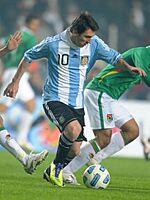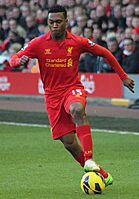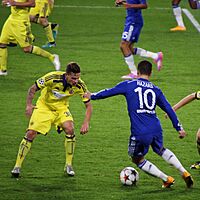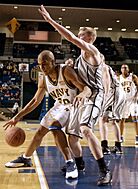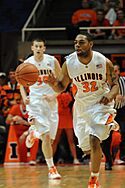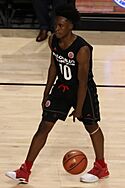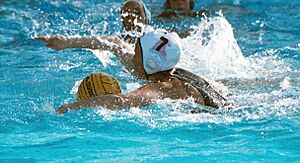Dribbling facts for kids
In many sports, dribbling means moving a ball while you are also moving. You control the ball and try to get past other players who want to take it from you. When you dribble well, you can get the ball into a good position to score points or goals!
Contents
Dribbling in Football (Soccer)
- Left: Lionel Messi gets past two players in a match for Argentina vs. Bolivia
- Centre: Daniel Sturridge dribbles on the break in a match for Liverpool
- Right: Eden Hazard (wearing no. 10) taking on opposition players from Maribor during a dribble for Chelsea.
In association football, also known as soccer, dribbling is a very important skill. It's how players move the ball towards the other team's goal. To get past an opponent, players use many clever tricks and fake moves, called feints. For example, the famous player Ronaldinho used a special move called the elastico to trick defenders.
Dribbling is super helpful, especially near the opponent's goal or on the sides of the field. It helps players create space when defenders are close. A good dribble can lead to a goal or a chance to score. But if you don't control the ball well, a defender might take it from you. Some players, like Gareth Bale, use their speed to get past opponents. Others, like Luis Suárez, might kick the ball right through a defender's legs, which is called a nutmeg. Players like Lionel Messi use quick changes in direction, amazing control, and clever fakes to get away from defenders.
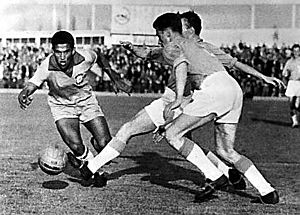
It's tough to take the ball from a skilled dribbler. If a defender tries to tackle and misses the ball, it can lead to a free kick for the dribbler's team. The defender might even get a penalty card. At the 2018 FIFA World Cup, Eden Hazard from Belgium showed amazing dribbling skills. He completed all ten of his dribbles in a game against Brazil, setting a World Cup record!
People have been dribbling for a very long time! Early stories about football games in England mention similar skills. For example, in the 1300s, the writer Geoffrey Chaucer described something like a ball rolling "under foot." Later, in the late 1400s, a description of a game in England talked about players moving a large ball by "skillfully rolling it along the ground" with their feet. This shows that dribbling has been a part of football for centuries. The idea of passing the ball to teammates became a rule in 1863, when The Football Association was formed.
Dribbling in Basketball
In basketball, dribbling means bouncing the ball on the floor over and over again. You use one hand at a time to do this. It's the only legal way to move around the court while holding the ball. If you stop dribbling, you must pass or shoot.
Dribbling helps players move the ball across the court. It lets them get away from defenders and create chances to score. It's a basic but very important skill in basketball.
When James Naismith invented basketball, his first rules only mentioned passing the ball. But players quickly found a clever way to move the ball by "passing to themselves." This idea grew into the dribbling we know today. Yale University was the first team known to dribble in 1897. By 1909, players were allowed to dribble continuously and even shoot while dribbling.
Dribbling makes the game much faster and creates more chances to score. But it also gives the other team a chance to "steal" the ball while you're bouncing it. Once you stop dribbling and hold the ball, you must either pass it or shoot. If you dribble, then hold the ball, and then start dribbling again, that's a foul called a "double dribble" or "carrying." The referee will stop the game and give the ball to the other team. You also get a "double dribble" if you try to dribble with both hands at once.
To dribble well, use your fingertips, keeping your fingers relaxed and spread out. Your wrist should push the ball down, and your forearm should move up and down. Good dribblers keep the ball low to the ground. This makes it harder for defenders to steal it. Amazing dribblers can bounce the ball behind their backs or between their legs. They can also change how fast they dribble. This makes them very hard to guard and gives them more choices to pass, shoot, or drive to the basket. In today's NBA, Stephen Curry of the Golden State Warriors and Kyrie Irving of the Dallas Mavericks are known as some of the best ball handlers. Other great dribblers include Trae Young of the Atlanta Hawks and Jamal Murray of the Denver Nuggets.
The National Association of Basketball Coaches (NABC) was started in 1927. One reason it was formed was to stop people from trying to remove dribbling from basketball!
Dribbling in Water Polo
In water polo, dribbling means moving the ball while you swim forward. Players push the ball ahead of them using the waves (called a wake) made by their arms as they swim. They might also gently nudge the ball with their nose or forehead. Because the player touches the ball very little, it's hard for defenders to take it. A defender can only touch the attacker if the attacker is touching the ball. Players use quick, short arm strokes with high elbows to protect the ball from opponents. This makes it tough for the other team to steal the ball, especially if they are behind or next to the dribbler. This way of dribbling is allowed by FINA, the world swimming body. So, defenders must be careful not to make contact when trying to steal the ball.
Other Sports with Similar Skills
Many sports have special rules about how players can move with the ball. These rules make the game more challenging and fair. They stop players from just grabbing the ball and running across the whole field easily. Here are some skills similar to dribbling in other sports:
- In Gaelic football, a "solo" is when a player kicks the ball to themselves while running.
- Also in Gaelic football, a "hop" is when a player bounces the ball on the ground and catches it again while running.
- In Australian rules football, a "running bounce" is when a player bounces the oval-shaped ball on the ground and catches it while running.
See also
 In Spanish: Regate para niños
In Spanish: Regate para niños
- Glossary of association football
- Basketball moves
- Glossary of water polo
- Seal dribble
- Step over


